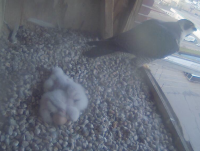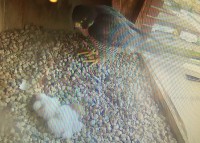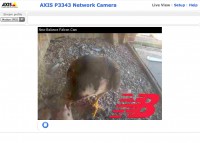 The forecast for today calls for a chance of rain, mainly after 4pm. Mostly cloudy, with a high near 53. Light northeast wind becoming east 8 to 13 mph in the morning. Winds could gust as high as 24 mph. Chance of precipitation is 30%. For tonight, rain, mainly after 7pm, fog after midnight, low around 39F. Northeast wind around 10 mph, with gusts as high as 23 mph. The nest box faces to the west, so the chicks will be out of the direct wind. The female will start taking more breaks like this, from active brooding.
The forecast for today calls for a chance of rain, mainly after 4pm. Mostly cloudy, with a high near 53. Light northeast wind becoming east 8 to 13 mph in the morning. Winds could gust as high as 24 mph. Chance of precipitation is 30%. For tonight, rain, mainly after 7pm, fog after midnight, low around 39F. Northeast wind around 10 mph, with gusts as high as 23 mph. The nest box faces to the west, so the chicks will be out of the direct wind. The female will start taking more breaks like this, from active brooding.
Now let’s take a look at an overview of growth and development over the total 40 days. Here’s a bit of what to expect:
At 5 days after hatch, their mass has doubled. The eyas can sit with relative ease, and the open eyes are more round.
At 6–8 days of age the second down (mesoptile or preplumulae) starts to emerge, first on humeral and alar tracts but no down visible on belly at 6 day, although on the legs and belly at 8 days. Also second down is well out on the wings and looks a bit blueish and sheaths of primaries breaking skin on wings.
By 10 days of age the second down is complete and uniform and outer rectrices are breaking skin. At 10 days, primaries growing at 2–3 mm/d, rectrix sheath not yet split.
At 14 days the second down is dense and long, rectrix sheath about 2 mm and typically ninth primary emerges from sheath.
By day 17 the contour feathers start to push out prepennae and only pale (buffy) tips of rectrices have emerged but growing at about 2 mm/d (since day 13).
By 10 days of age the second down is complete and uniform and outer rectrices are breaking skin. At 10 days, primaries growing at 2–3 mm/d, rectrix sheath not yet split.
At 14 days the second down is dense and long, rectrix sheath about 2 mm and typically ninth primary emerges from sheath.
By day 17 the contour feathers start to push out prepennae and only pale (buffy) tips of rectrices have emerged but growing at about 2 mm/d (since day 13).
At 20 days while still with heavy coat of second down, brown contour feathers are visible on margins of wings, tail, and faintly around the eyes.
By 30 days young appears about half down-covered and half feathered; while side of face well feathered, crown still covered with down.
At 35 days while mostly feathered, large conspicuous patches of down around legs, under wings, and on crown.
At 40 days almost fully feathered with traces of down on crown and under wings and outer several remiges; rectrices not fully grown but bird capable of weak flight.
Literature cited:
Veldhuis, Froona, Eyases growth and development http://falcoperegrinus-froona.blogspot.com/2008/04/eyases-growth-and-development.html
 Finally the fourth egg has hatched and the hatchlings are all gathered in close together and being warmly brooded by the female! In most years, the eggs tend to hatch close to one another in a fairly well synchronized way, and within 24 – 48 hours of each other. We have seen the remaining egg shells around the hatchlings. The adults may move these around a bit with their bills. They may seem to nibble a bit on the broken pieces, but they don’t have a well developed habit for disposal of the egg shells. For the most part, the remaining pieces of egg shell will become trampled. Here the male departs as the female gets down to feeding the hatchlings!
Finally the fourth egg has hatched and the hatchlings are all gathered in close together and being warmly brooded by the female! In most years, the eggs tend to hatch close to one another in a fairly well synchronized way, and within 24 – 48 hours of each other. We have seen the remaining egg shells around the hatchlings. The adults may move these around a bit with their bills. They may seem to nibble a bit on the broken pieces, but they don’t have a well developed habit for disposal of the egg shells. For the most part, the remaining pieces of egg shell will become trampled. Here the male departs as the female gets down to feeding the hatchlings! The hatchlings have a delicate white down at birth, with none of the coloration that will come later with true feathers. They form a feathery white cluster in the first few days and remain in very close contact with one another as though in a rugby scrum! It is always a joy to watch the female feeding in her new little family. she does so with care and tenderness, making sure all receive a fair portion.
The hatchlings have a delicate white down at birth, with none of the coloration that will come later with true feathers. They form a feathery white cluster in the first few days and remain in very close contact with one another as though in a rugby scrum! It is always a joy to watch the female feeding in her new little family. she does so with care and tenderness, making sure all receive a fair portion.









